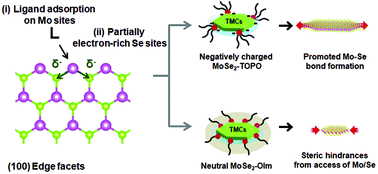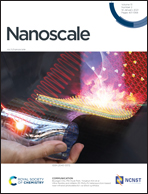Unveiling surface charge on chalcogen atoms toward the high aspect-ratio colloidal growth of two-dimensional transition metal chalcogenides†
Abstract
Controlling surface energies of each facet is essential for the anisotropic growth of two-dimensional transition metal chalcogenides (TMCs). However, it is a challenge due to stronger binding energies of ligand head groups to the edge facets compared to the planar facets. Herein, we demonstrate that the adsorption of ligands on metal positions can induce partial electron localization on the chalcogen sites, and then accelerate metal–chalcogen bond formation for enhanced anisotropic growth of nanosheets. And only in the case of trioctylphosphine oxide (TOPO)-adsorbed nanosheets, surface polarization can be unveiled on the surface of the colloidal nanosheets due to restricted development of nonpolar ligand shells by the steric effects of the ligands. Moreover, density functional theory (DFT) calculation results reveal that the decrease of surface energy on the (100) edge facets as well as the increase on the (001) basal facets by the adsorption of triorganylphosphine oxide also contribute to the preferentially lateral growth. As a result, various 2D TMCs, including MoSe2, WSe2, and SnSe2 synthesized with TOPO, show enhanced anisotropic growth.



 Please wait while we load your content...
Please wait while we load your content...